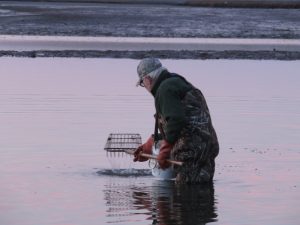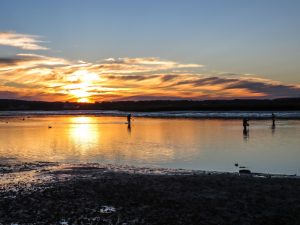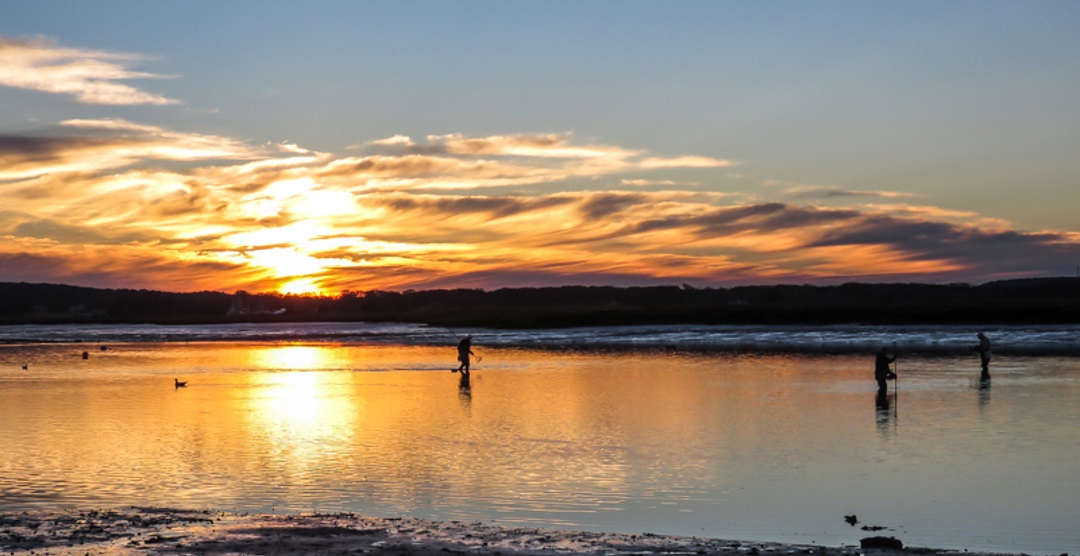Water Closet for November 17, 2017
Dark and light green grasses
In cowlicks swirl ’tween soft mud creeks
Levied by dune and upland rock
Watering place for more than ducks,
Has depth and breadth
Beyond its bounds.
Where larval travelers get their start
And subtler cycles turn
To nourish out a thousand miles.
Estuaries made up of salt marshes, submerged eel grass beds, creeks, tidal flats, sand bars, and oyster reefs are nurseries for many marine animals. Several Middleton Stream Teamers rake oysters at low tide in Ipswich’s Eagle River. In August team members took an evening cruise from downtown Portsmouth up into Great Bay, the area featured in the following article from The Working Waterfront, November 2017 issue.
FATHOMING*
Restoring wild oyster beds, one acre at a time: Projects underway in New Hampshire and Phippsburg, Maine, to clean waters
By Heather Deese and Susie Arnold
NEW YORK CITY has its Billion Oyster Project, and now New Hampshire’s Great Bay has its own 25-acre project, with help of from fishermen in Phippsburg.
Like many estuaries along the U.S. Atlantic coast, Great Bay was once a maze of channels flowing through a complicated oyster reef system that covered more than 85 percent of the bay. Over the centuries of harvest and other human activities, oyster populations decreased dramatically, until only about 10 percent of the bay supported reefs. Now that trend is reversing, as neighbors around the bay are working with the Nature Conservancy of New Hampshire, the University of New Hampshire, and others to restore the oyster reefs.

“Fran,” “Frank,” Francis Masse of Middleton thigh deep in winter water with oyster rake. He is hunting the largely unseen bottom for sedentary prey. In the background are the low tide flats of Eagle River, Ipswich. – Judy Schneider photo
Since 2009 the project has restored 20 acres of reefs. The oysters pump massive amounts of water through their systems, improving water quality as they remove excess nutrients and particles, resulting in clearer water. This means the oyster reefs help deal with sedimentation, which is currently a major issue for Great Bay, which is fed by seven rivers.
Clearer water also helps sea grasses thrive because more sunlight can reach the seafloor. Seagrass beds, and the oyster reefs themselves, provide excellent habitat for juvenile fish and other species. An estimated 70 percent of commercial marine fisheries species in the northeast U.S. live in estuaries for part of their lifecycle; better estuary habitat should benefit our commercial fisheries in the long-term.
This past summer the project was in high gear. Over the course of three long days, 500 cubic yards of clam shells were deployed from a barge to the bottom of the bay, creating a new reef with a five-acre footprint.
Baby oysters are grown by volunteers with waterfront access to the bay, who monitor oyster spat, or baby oysters, for about 12 weeks over the summer. Once the oysters get to be approximately an inch to an inch and a half in length, they are towed out and hand seeded on the reef and supplemented with additional baby oysters grown by the team in a growing facility.

Middleton Stream Teamers on annual outing under an overcast sky cross Great Bay off the Piscataqua River. Two fathoms beneath them are oyster reefs and eel grass beds. – Sandy Rubchinuk photo
While the project’s goals are focused on the environmental and ecosystem benefits of oyster restoration, Alix Laferriere, The Nature Conservancy’s coastal and marine director for New Hampshire, believe that what may be more important than the ecosystem benefits are the community engagement outcomes.
“The volunteer oyster conservationists who are growing oysters at 91 sites around the bay have become vocal, energetic advocates for oyster restoration,” he said.
The project has been such a success that the Maine chapter of The Nature Conservancy has started a pilot project in the Basin Reserve in Phippsburg. Due to the undeveloped nature of the Basin, pilot project partners aim simply to see if they can successfully grow oysters on the seafloor at a place known to previously be habitat for wild oysters.
Project leader Jeremy Bell, The Nature Conservancy’s river and coastal restoration director for Maine, initially pitched the idea to Phippsburg’s shellfish committee, and the response was positive.
“They said there used to be a lot more wild oysters in the Basin, and they whipped out the map to show me where you could grow oyster,” Bell said.
With a limited purpose-aquaculture lease in hand, Bell and partners from the University of New England, Casco Bay Estuary Partnership, and Maine Department of Environmental Protection and with advice from Maine Sea Grant, settled a half million oyster larvae onto tiles and in baskets of shells. After two weeks in the lab they were deployed in the Basin.
“Just putting the tiles and baskets out increased the bottom complexity and attracted critters – baby lobsters, fish, crabs,” he said. “And the oysters went from microscopic to fingernail size in just three months.”

Stream Teamers at low tide rake oysters in Ipswich at sunset. – Judy Schneider photo
Fortunately, we aren’t starting from scratch with these efforts. There is much to be learned from efforts elsewhere. Oyster restoration is occurring around the country and internationally. The Nature Conservancy and other groups in Massachusetts, Long Island Sound, and Chesapeake Bay as well as Australia and Europe have major oyster restoration projects underway.
Success stories are ripe for the picking, even if the oysters are to remain on the bottom.
Dr. Heather Deese is the Island Institute’s executive vice president. Dr. Susie Arnold is an ecologist and marine scientist with the organization. Their column in the Working Waterfront is called FATHOMING. The Working Waterfront is published by the Island Institute in Rockland, Maine.
__________________________________________________________
WATER RESOURCE AND CONSERVATION INFORMATION
FOR MIDDLETON, BOXFORD AND TOPSFIELD
| Precipitation Data* for Month of: | Aug | Sept | Oct | Nov | |
| 30 Year Normal (1981 – 2010) Inches | 3.37 | 3.37 | 4.44 | 4.55 | |
| 2017 Central Watershed Actual | 1.22 | 2.44 | 5.8 | 0.3 | |
Ipswich R. Flow Rate (S. Middleton USGS Gage) in Cubic Feet/ Second (CFS):
For Nov 9, 2017 Normal . . . 49 CFS Current Rate . . .11.6 CFS
—————————————————————–
*Danvers Water Filtration Plant, Lake Street, Middleton is the source for actual precipitation data thru Sept.
** Middleton Stream Team is the source of actual precipitation data for Oct and Nov.
Normals data is from the National Climatic Data Center.
THE WATER CLOSET is provided by the Middleton Stream Team: www.middletonstreamteam.org or <MSTMiddletonMA@gmail.com>


loa hk3 hello my website is loa hk3
runbot hello my website is runbot
qqole hello my website is qqole
y8 play hello my website is y8 play
OPPO A57 hello my website is OPPO A57
Easybet hello my website is Easybet
jsEncrypt hello my website is jsEncrypt